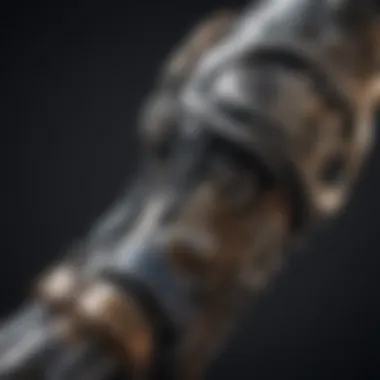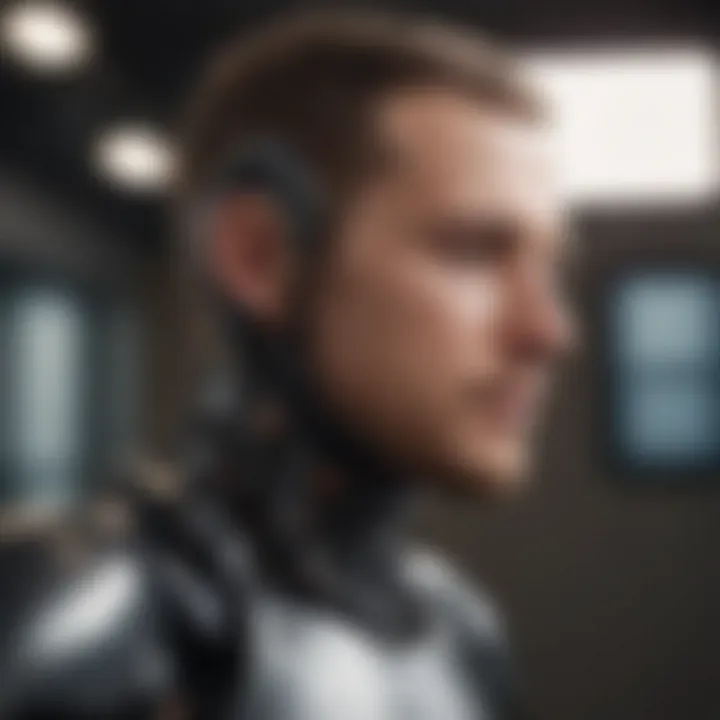Advancements in Prosthetic Technology: 2021 Insights


Intro
The evolution of prosthetic technology marks a pivotal shift in the way we understand mobility and rehabilitation. Over recent years, particularly in 2021, advancements have not only enhanced functionality but have also shifted focus towards the needs and desires of users. For individuals adjusting to life with amputated limbs, these innovations symbolize hope and a return to autonomy. This article seeks to traverse the landscape of these developments, from cutting-edge engineering technologies to the thoughtful designs that place the user at the center.
The integration of biomechanics and artificial intelligence has underscored a burgeoning trend. What’s more, the implications of these technologies extend beyond mere physical capabilities, often delving into psychological and emotional realms as well. With that said, let’s unpack the details further.
Research Overview
Summary of Key Findings
In 2021, key findings from various studies illustrated significant shifts in prosthetic technologies. Several breakthroughs were highlighted, including:
- The introduction of adaptable prosthetics that customize to individual lifestyles,
- Smart devices equipped with sensors that provide real-time feedback,
- Advancements in materials, notably lighter and more durable composites.
These strides not only offer fresh solutions but reshape how we perceive functionality and integration by focusing on personalization.
Relevance to Current Scientific Discussions
The surge in prosthetic innovation correlates closely with ongoing discussions in biomechanics and rehabilitation sciences. Researchers and technologists are increasingly exploring how:
- User empowerment through interface designs facilitates better outcomes,
- Collaboration among engineers, health professionals, and users enhances prosthetic design,
- Ethical considerations around technology and accessibility remain crucial.
This fusion of disciplines is pivotal as it encourages an ongoing dialogue about the human experience and technology's role within it, keeping in mind societal implications and inclusivity.
"Prosthetics today are not just tools; they are gateways to new realities for those who embrace them."
As we delve deeper into the methodologies therein, it becomes clear that a user-focused approach plays a vital role in driving forward these innovations, ensuring that technology and human experience are integrated seamlessly.
Prosthetic Technology Overview
Prosthetic technology is more than just a field of study; it is a lifeline for many individuals facing the challenges of limb loss or disability. The advancements in this domain can remarkably enhance everyday life, facilitating mobility, independence, and a sense of normalcy for many amputees. With ongoing innovations, the technology not only provides functional support but also integrates aesthetic considerations, making it vital for users to feel comfortable and confident with their prosthetics.
Definition and Significance
Prosthetic technology refers to the engineering and design of artificial limbs, devices, and systems that assist, replace, or enhance natural body functions. Its significance cannot be overstated; these devices have evolved from rudimentary wooden legs to highly advanced, intelligent systems that can mimic the movement and appearance of biological limbs. The importance lies in the life-altering capabilities they provide. Individuals can reclaim their autonomy, engage in physical activities, and integrate more fully into society. In 2021, key innovations—such as lightweight materials and smart technologies—have taken these benefits to new heights.
"The advancement of prosthetic technology is not just about mechanics; it's about restoring life to its fullest potential."
Historical Context
Understanding the progress of prosthetic technology requires a glimpse into its rich history. The earliest known prosthetic dates back to ancient Egypt, where wooden toes were fashioned for mummies, serving both practical and ceremonial purposes. Fast forward to the 16th century, and we see artists like Ambroise Paré introducing metal prosthetics that were quite revolutionary for their time.
In the late 20th century, developments accelerated with the introduction of materials like carbon fiber, which allowed for greater flexibility and strength. Meanwhile, the 21st century witnessed the birth of bionic limbs, integrating computerized systems that react to muscle signals. These enhancements not only improved functionality but also marked a significant leap toward natural movement mimicry. The journey from simple aids to intricate devices mirrors advancements in technology and reflects a deepening understanding of human needs and aspirations.
In this ongoing narrative of progress, we find ourselves in 2021, standing on the shoulders of giants, ready to explore the next chapter of this fascinating evolution.
Advancements in Prosthetic Materials
The world of prosthetics is rapidly evolving, and the introduction of new materials plays a pivotal role in this transformation. Over recent years, advancements in prosthetic materials have not only improved the functionality of prostheses but have also significantly impacted the comfort and quality of life for users. As we delve into this subject, we will explore lightweight composites, smart materials, and biocompatibility considerations—all crucial elements that contribute to the enhancement of prosthetic technology.
Lightweight Composites
Lightweight composites have emerged as a game changer in the prosthetic field. These materials, which combine two or more distinct components, provide excellent strength-to-weight ratios. For instance, carbon fiber reinforced plastics are lightweight yet incredibly durable, allowing for prosthetic limbs that do not weigh users down while offering resilience against wear and tear. The lighter a prosthetic limb is, the easier it becomes for users to maneuver and engage in everyday activities, from walking to participating in sports.
Moreover, the precision manufacturing techniques employed in creating these composites enable the development of custom-fit components. Tailoring the prosthetic design to the specific needs of the user ensures a more personalized experience, paving the way towards improved adaptation and comfort. This personalized approach caters to the unique biomechanics of each individual, limiting the risk of injuries caused by ill-fitting devices.
Smart Materials
Smart materials are another breakthrough in the realm of prosthetics. These innovative materials respond to external stimuli, such as changes in temperature or pressure, allowing prosthetic devices to adapt in real-time. For example, shape-memory alloys can revert to a predetermined shape when subjected to heat, thus allowing prosthetic joints to replicate natural movement more effectively.
Additionally, electroactive polymers can change shape or size when electrically stimulated, providing functional movement that closely mimics that of biological muscles. This technology holds great promise for improving the fluidity of motion and facilitating more intuitive control for users. On top of that, integrating sensors within smart materials can also help monitor user performance, making adjustments to enhance comfort and stability during different activities.


"The fusion of smart materials and prosthetic technology offers profound potential for creating limbs that are not just replacements, but extensions of the human body."
Biocompatibility Considerations
When it comes to advancements in prosthetic materials, biocompatibility is a significant consideration. This term refers to the compatibility of materials within the human body, particularly concerning how they interact with biological tissues. It's crucial to select materials that do not trigger adverse reactions, ensuring long-term acceptance and comfort for the user.
Innovations in polymers and titanium alloys have been made to enhance biocompatibility. For instance, using materials that allow for better integration with the body has shown promise in minimizing complications such as infection and inflammation. Additionally, advances in surface treatments have led to better bonding between the prosthetic device and the user’s natural bone or skin, enhancing overall functionality.
Moreover, ongoing research continues to develop bioactive materials that can promote healing and tissue regeneration, further improving the synergy between prosthetic limbs and users.
In summary, advancements in prosthetic materials are not just about creating lighter or stronger devices; they’re equally about enhancing user experience and safety. Embracing innovative materials like lightweight composites, smart materials, and ensuring biocompatibility signifies a thoughtful progression in this field, particularly pivotal in 2021. The ongoing evolution of materials will undoubtedly continue to shape the future of prosthetic technology.
Technological Innovations in Prosthetics
Prosthetics have seen enormous strides due to technological innovations. These developments are reshaping the landscape of mobility solutions for amputees and individuals with movement-related challenges. At its core, the relevance of these innovations lies not just in enhancing functionality, but also in improving the overall quality of life for users. The marriage of advanced materials, adaptive technologies, and user-centered design creates a nuanced and impactful narrative that affects millions globally.
Bionic Limbs
Bionic limbs represent a significant leap in prosthetic technology. Unlike traditional prostheses, which often serve merely as substitutes, bionic limbs utilize advanced electronics and sensors to mimic natural movement. This technology transforms how users interact with their environment. For instance, the introduction of components such as electromyographic sensors enables the prosthetic limb to interpret electrical signals from residual muscles. As a result, the user can control movement with surprising precision.
In practical terms, this means that tasks like picking up a glass, navigating uneven terrain, or even social interactions become more seamless. Moreover, the psychologically uplifting aspect of regaining autonomy cannot be understated. These high-tech appendages foster not just physical rehabilitation but also emotional health, offering a sense of wholeness and capability.
Neuroprosthetics
Neuroprosthetics delve into the fascinating junction of neuroscience and engineering. This branch focuses on restoring sensory or motor functions through direct stimulation of the nervous system. By embedding electrodes within the brain or peripheral nerves, neuroprosthetics can create direct feedback from the brain to the prosthetic. This technology allows users to not only move their prosthetics with their thoughts but also regain some level of tactile sensation.
Such advancements raise the bar significantly when it comes to amputation rehabilitation. For example, individuals fitted with a neuroprosthetic jaw can potentially regain the ability to taste and chew, fundamentally altering their eating experience. While this technology is still under rigorous study, the implications for mobility and autonomy are vast. Neuroprosthetics showcase a future where, with enough research and development, brain-computer interfaces lead to improvements that were once the realm of science fiction.
3D Printing Applications
The advent of 3D printing technology has revolutionized many industries, and prosthetics is no exception. This innovation allows for rapid prototyping of customized prosthetic parts tailored specifically to an individual’s anatomy. Unlike mass-produced prosthetics, 3D-printed limbs can be crafted to fit each user perfectly, providing comfort and functionality that can be adjusted based on the user’s activities.
Additionally, 3D printing makes prosthetics more accessible due to lower production costs and faster manufacturing times. This has significant implications in terms of affordability and availability in under-resourced regions. For instance, small clinics can utilize 3D printing to produce prosthetic limbs on-site, reducing wait times and lowering costs for patients.
"In the future, we may see a world where 3D printing can provide a new limb within hours, directly addressing individual needs and preferences."
The dynamic capabilities of 3D printing also extend into design innovation. Design can easily adapt based on user feedback or technological improvements, ensuring that prosthetic technologies evolve continually in line with user requirements.
User-Centric Design Approaches
User-centric design in prosthetics is a game changer, bridging the gap between advanced technology and user needs. This approach puts the individuals who use prosthetics at the forefront, recognizing that their comfort, functionality, and personal preferences are paramount. It's not just about creating a tool that works; it's about crafting a solution that integrates smoothly into the daily lives of users, improving their quality of life.
Personalization of Prosthetics
Personalization of prosthetics has gained significant traction in recent years, transforming how amputees interact with their artificial limbs. Customization pushes beyond mere aesthetics; it delves into the very fabric of functionality. Individuals can now choose materials, colors, and features that resonate with their lifestyles.
For example, a marathon runner might want a lightweight, aerodynamic limb designed for speed, while a parent might prioritize a durable, all-terrain prosthetic that can withstand the rigors of family life. This tailoring can enhance not only performance but also the emotional connection between the user and the prosthetic device.
Moreover, advances in manufacturing, particularly through 3D printing, allows for a level of detail and personalization that was unimaginable a few decades ago.
"Personalized prosthetics empower users, making them feel more in control and improving their self-esteem."
User Feedback Mechanisms
User feedback mechanisms play a crucial role in refining prosthetic designs. These systems allow users to share their experiences, insights, and challenges with the manufacturers and designers. Feedback can be collected through interviews, surveys, or technology-integrated devices that monitor usage patterns.
By actively engaging with users, designers can gather actionable insights that fuel further innovations. Things like ease of use, comfort, and functionality directly influence design choices for future prosthetics, ensuring they better align with the actual needs of the users rather than prescriptive specifications decided in isolation.
Additionally, some companies have started to implement real-time feedback loops into their devices, meaning users can directly send performance data back to the manufacturers. This continuous improvement cycle enhances not only product design but fosters a sense of community and involvement among users.
Cultural and Psychological Factors


Cultural and psychological factors deeply influence the reception of prosthetic technology. People from different backgrounds may have varying perceptions of disability and prosthetics, affecting their willingness to adopt these technologies. In many cultures, having a prosthetic may carry stigmas or represent differences, which means a thoughtful design is key to combating these perceptions.
Moreover, adjusting psychologically to limb loss and the transition to using prosthetics can be as significant as the physical adaptation. Specialized support programs addressing these psychological aspects are becoming increasingly recognized in the industry. To resonate with users, prosthetics must not only perform functionally but also help restore a sense of normalcy, identity, and actually promote positive self-image.
Including cultural consultants in the design and development process can facilitate creations that respect and accommodate various cultural identities.
In essence, user-centric design is not merely a trend; it is an indispensable approach in the evolving landscape of prosthetic technology. As we move forward, what remains clear is that keeping users' experiences, wants, and cultural contexts at the heart of design will result in innovations that truly empower them.
Integration of Robotics and AI in Prosthetics
The integration of robotics and artificial intelligence (AI) in prosthetic technology marks a remarkable shift in how these devices function. This confluence of advanced technologies not only enhances the performance of prosthetics but also allows for more natural interactions between the user and their artificial limb. As we advance into an era where technology significantly shapes our daily lives, understanding these innovations becomes essential for both professionals in the field and those seeking solutions for mobility challenges.
Using robotics and AI in prosthetics provides a multitude of benefits, from improving mobility to enabling users to perform a broader range of activities. For instance, while traditional prosthetics often required considerable effort to operate, robotic prosthetics can respond to sensory feedback, allowing for smoother and more intuitive movements.
The design and functionality of modern prosthetics have changed dramatically. For users, these improvements translate to higher confidence levels, reduced fatigue, and enhanced autonomy. With a deeper understanding of the implications of robot and AI technologies in prosthetics, we can appreciate their potential to transform lives.
Autonomous Movement
One of the standout features of robotic prosthetics is their ability to facilitate autonomous movement. Unlike conventional models that function purely based on manual input, these advanced devices utilize sensors and algorithms that mimic natural limb motion.
These prosthetics often incorporate specialized sensors that detect changes in gait and balance. For instance, an ankle-foot prosthesis equipped with a microprocessor can automatically adjust to varied terrains, such as shifting from a smooth surface to uneven ground. This ability to adapt in real time helps reduce the risk of falls and improves overall user safety.
Key aspects of autonomous movement include:
- Adaptive Control: Robots learn from user movements and make adjustments based on fluidity and precision.
- Enhanced Stability: As the limb automatically adapts to environmental shifts, stability is significantly improved.
- Person-Centered Experience: Users engage with their prosthetics instinctively, increasing comfort and confidence.
This combination of responsiveness and stability markedly enhances the user experience and paves the way for more sophisticated and user-friendly prosthetic designs.
AI-Driven Control Systems
The backbone of this modern approach to prosthetics is the AI-driven control systems that manage movements. These systems analyze input from sensors and then execute commands with high precision. The algorithms in these systems work as a brain for the prosthetic, ensuring that movements are smooth and intentional.
An important aspect of AI in this regard is its capacity for learning. For example, machine learning algorithms can adapt to a user’s unique walking pattern over time, refining the precision of movement control. This learning process allows for:
- Personalization: Each user has individual needs, and AI adapts accordingly to enhance their experience.
- Predictive Functionality: AI can foresee potential obstacles, adjusting movements proactively.
- Real-Time Feedback: Users receive immediate corrections and adjustments based on sensor data, making the prosthetics feel like an integral part of their own body.
In essence, the integration of robotics and AI into prosthetics provides not only functional improvements but also a more holistic approach to user engagement. By closely aligning technology with the human experience, these innovations foster a future where mobility and independence are accessible to all.
Impact of Digital Technologies
In the realm of prosthetics, digital technologies have emerged as game changers, reshaping how devices are designed, fitted, and monitored. The integration of telemedicine and data analytics not only optimizes the user experience but also streamlines the overall prosthetic lifecycle. By harnessing these advancements, the industry has shifted towards a more client-centric model that prioritizes the needs and comfort of users.
These innovations resonate throughout the field, driving significant improvements in accessibility, customization, and continual support for users. Benefits include quicker adjustments, personalized fittings, and performance tracking, allowing users to lead active lives with minimal frustration.
"Digital technologies are not just tools; they are bridges to better living for amputees, turning challenges into opportunities."
Telemedicine in Prosthetic Fitting
Telemedicine, once a luxury, is now quietly transforming prosthetic fitting processes. The ability for patients to consult remotely with prosthetists saves time, money, and energy for everyone involved. Rather than traditional in-person fittings, which can be a logistical headache, patients can now engage in virtual consultations.
This shift is beneficial in numerous ways:
- Convenience: Patients don’t have to travel long distances, making it easier for those living in rural areas or with mobility issues.
- Immediate Adjustments: Prosthetists can provide real-time feedback and make immediate recommendations, enhancing the fitting process.
- Historical Tracking: Through remote sessions, practitioners can keep digital records of fittings, allowing for better monitoring of adjustments over time.
The use of mobile applications and virtual reality can also augment the fitting experience, providing users insights into how their prosthetic may fit and function even before the physical device is ready.
Data Analytics for Performance Monitoring
Data analytics plays a pivotal role in enhancing prosthetic performance. With sensors embedded in modern prosthetics, real-time data can be collected about how users navigate their daily lives. This information is invaluable for assessing the effectiveness of devices and identifying areas for improvement.
- Performance Metrics: Users can track metrics such as walking speed, gait symmetry, and energy consumption.
- Personalized Adjustments: With analytic insights, prosthetists can fine-tune prosthetics to better meet individual user needs. The goal is to create devices that are not only functional but feel like an extension of one’s body.
- Research and Development: Data accumulated over time can inform future designs and enhancements, paving the way for smarter, more adaptive prosthetic technology.


Through these mechanisms, the utilization of data analytics transcends conventional tracking, driving innovations that significantly improve user experiences. As this field evolves, the synergy between digital technologies and prosthetic solutions will likely continue, fostering even more profound advancements.
Accessibility and Affordability Issues
When it comes to prosthetic technology, the terms accessibility and affordability are often thrown around, but their significance can’t be overstated. Revealing the benefits of these elements goes beyond mere discussions; it touches the very essence of what it means to live with a disability. This section will delve into how accessibility and affordability play an important role in the acceptance and utilization of advanced prosthetic solutions.
Cost of Advanced Prosthetics
The cost associated with advanced prosthetics has been a perennial issue. Prices can range from a few thousand dollars to well beyond $100,000 depending on the technology and features involved. Factors contributing to the cost include the materials used, the integration of smart technology, and even the level of personalization that patients often desire.
Why is it so high?
- Technology Integration: Equipment like bionic limbs or neuroprosthetics often include sensors and motors that respond to neural signals. These complex systems demand rigorous engineering and materials, which inflates costs.
- Customization: Every individual is unique, not just in physical size but in lifestyle preferences. Creating a prosthetic that caters to personal requirements requires bespoke manufacturing, increasing the cost.
- Maintenance: Advanced prosthetics need periodic check-ups and potential repairs, the cost of which contributes to the overall financial burden.
Policy Implications
With the rising costs of advanced prosthetics, the role of policy becomes ever more critical. Active engagement from lawmakers can make a world of difference in ensuring that the technologies remain accessible to those who need them most.
"Access to affordable prosthetics should not be a privilege, but a right."
Policies can influence various factors:
- Insurance Coverage: Many insurance plans do not adequately cover advanced prosthetic technologies, leaving patients to shoulder massive out-of-pocket expenses. Improving coverage is not just beneficial; it’s necessary for inclusion.
- Subsidies and Grants: Government initiatives can help subsidize costs for individuals, especially those from low-income backgrounds. This financial aid can promote innovations and widen the gap between the existing disparities in access.
- Education and Awareness: Another angle is to boost awareness about what’s available, such policies can enhance public education, helping the people understand their rights and the options they have for funding their prosthetics.
Access to quality prosthetics should not be reserved for those who can foot the hefty bill. Both accessibility and affordability are critical in reshaping not only individual lives but also communities as a whole, enhancing the quality of life for countless individuals.
Future Directions in Prosthetic Technology
The future scope of prosthetic technology is a crucial topic, as it revolves around not only improving the physical capabilities of amputees but also enhancing their overall quality of life. Each development opens new avenues for research and application, moving beyond just mechanistic solutions to encompass holistic user experiences. With rapid advancements in materials and technologies, the coming years are poised to challenge traditional paradigms.
It's worth noting that discussions around future directions often capture the imagination of students, researchers, and professionals alike. Emerging innovations in this field promise numerous benefits such as increased functionality, greater personalization, and wider accessibility.
Emerging Research Areas
The landscape of prosthetic technology is evolving, largely thanks to burgeoning research areas that seek to push boundaries. One of the compelling areas of focus is the integration of bioengineering principles into prosthetic designs. This field aims to utilize biologically-inspired systems that mimic natural limb functionalities. For example, researchers are exploring methods to use electrical signals from muscles to control prosthetics more intuitively.
Another area of interest is the study of wearable devices and how they can interact with prosthetics. Devices like smart bands or health-tracking wearables can relay critical data about usage patterns and performance, enabling an almost real-time adjustment of the prosthetic’s settings.
Furthermore, ongoing exploration into 3D printing technologies might revolutionize the customization aspect. Imagine a patient receiving a prosthetic that is not just functional but tailored to their specific aesthetic preferences as well. Emerging companies are already testing these waters, making strides in combining utility with personal expression.
Global Trends to Watch
As we peer into the future, several global trends merit attention. One significant trend is the increasing focus on sustainability in prosthetics manufacturing. With awareness around environmental impacts growing, many developers are pivoting to eco-friendly materials. For instance, the advent of biodegradable plastics could change the game, ensuring that discarded prosthetics contribute less to landfill overruns.
In addition, there is rising participation from a diverse range of nations in this technology’s development sphere. Countries with robust engineering schools and health technology research centers are stepping up, enhancing global collaboration. The consequence is a sharing of knowledge and resources, leading to richer, more innovative solutions than one region could develop alone.
Finally, the future integration of AI with prosthetics shows promise. We could see AI-enabled devices that learn from user behavior, thereby optimizing performance over time. This also opens doors to greater data analytics opportunities which could provide insights into usage trends that guide future designs.
"The innovations in prosthetic technology are not just about restoring function; they are about embracing a future where individuals can thrive redefined possibilities."
In summary, future directions in prosthetic technology encompass a wealth of exciting opportunities, be it through emerging research areas like bioengineering and 3D printing, or global trends leaning towards sustainability and AI integration. Each element contributes to a richer ecosystem designed to empower amputees and enhance their quality of life.
Epilogue
The field of prosthetic technology has undergone remarkable changes in recent years, particularly in 2021. The advancements discussed in this article not only reflect a technical evolution but also represent a profound shift in how we perceive mobility and accessibility. It's essential to recognize the significance of these developments as they greatly influence the quality of life for amputees and individuals facing mobility challenges.
Summary of Key Developments
This year has seen a range of notable innovations that intersect science and engineering, paving the way for smarter prosthetic solutions:
- Bionic Limbs: Enhanced functionality offering a more natural range of movement; these devices adapt dynamically to user movements, minimizing effort and increasing usability.
- Neuroprosthetics: Advances in neural integration have enabled more intuitive control, allowing users to interact with their prosthetic limbs seamlessly.
- 3D Printing: Customization reaches new heights, with tailored designs made through cutting-edge 3D printing technologies that match the individual’s specifications and needs.
- User-Centric Designs: Recognizing the psychological and cultural aspects of prosthetic use has led to more empathetic design practices that prioritize user feedback, making these devices extensions of one's own body rather than mere tools.
- AI Integration: The implementation of AI in the control systems promotes autonomous movement, revolutionizing how users experience prosthetics and significantly boosting their confidence and independence.
These developments illustrate a consolidation of technological prowess and a focus on individual user experience, fostering a more holistic approach to creating prosthetics.
Implications for Amputees and Society
The implications of these innovations extend beyond the individual amputee. Society at large can benefit in several ways:
- Increased Independence: Improved functionality translates to enhanced autonomy for users, allowing them to engage more fully in daily activities without limitations.
- Changing Perceptions: As prosthetics become more advanced, public perception may shift. Awareness campaigns can break down stigma associated with disabilities, paving the way for a more inclusive society.
- Healthcare System Advancement: The integration of digital technologies like telemedicine in prosthetic fitting can streamline the fitting process, making quality prosthetic care accessible to wider demographics.
- Economic Considerations: Affordable advanced prosthetics can lead to better employment opportunities for amputees, fostering economic inclusivity and growth.



